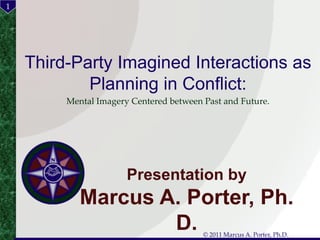
Ica
- 1. Third-Party Imagined Interactions as Planning in Conflict: Mental Imagery Centered between Past and Future.
- 2. Imagined Interactions (II) An II involves mentally visualizing a conversation involving the mental actor and one or more other parties. The individual who is mentally visualizing an interaction.
- 3. Third-Party Imagined Interactions (TPII) A TPII involves mentally visualizing a conversation involving at least two individuals other than the mental actor. The individual who is mentally visualizing an interaction.
- 7. rehearsal
- 9. compensation
- 11. self-dominance
- 12. discrepancy
- 13. retroactivity
- 14. proactivity
- 15. specificity
- 16. frequency
- 17. variety
- 19. Highlights of TPII Research Four of the characteristics discrepancy, retroactivity, proactivity and specificity are equivalent between IIs and TPIIs. IIs demonstrate more frequency, variety, and valence. Self-dominance was considered to be missing from TPIIs.
- 20. This Study The purpose of this study was to test the connection stated in previous II research about the linkage of imagery with future interactions. Specifically if actors would allow the imagery produced in a TPII to influence a future interaction.
- 21. The Prisoner's Dilemma The study utilizes a common game the prisoner’s dilemma to set up a conflict, and then induced a TPII regarding the co-conspirator.
- 22. The Prisoner's Dilemma The co-conspirator Tell Remain Silent Suspended from school but allowed to return later. The co-conspirator is expelled from school. Participant stays in class. Tell The participant The participant is expelled from school. Co-conspirator stays in class. Both fail class but remain in school. Remain Silent
- 23. Methods Participants were induced to have a TPII. The II was coded for whether the participant viewed the co-conspirator as telling or not (Kappa = 0.88) Participants were then asked if they would tell or not. Participants were asked if they met the alleged co-conspirator would they discuss the situation or hide their plans.
- 24. Hypothesis 1 Mental images developed by individuals influence their future actions, according to II conflict -linkage theory. Hypothesis 1 is to test the role of TPIIs in guiding future behavior: H1: Individuals choose the communicative behavior (seek / do not seek to communicate) that provides the best outcome given their mental image of the other’s choice to tell or not.
- 25. Hypothesis 2 Individuals who have more positive valence in the TPII will act upon the positive feelings, which influence whether or not to engage the other party. H2: Individuals who experience more positive valence in their TPII are more likely to seek engagement with the party imagined than are those who experience less positive valence in their TPII.
- 26. Hypothesis 1 Hypothesis 1 posited that a participant’s choice to engage in a communicative behavior was dependent on his or her mental image of the other’s choice. The result c2 (1, N = 284) = 40.073, p < .001 indicates that there is a difference in the plan to tell based on whether the imagined classmate told, thus supporting the hypothesis. The odds of the participant telling when their imagined classmate told are five and a half times the odds of the participant telling when his or her imagined classmate did not tell, OR = 5.591(95% CI = 3.203-9.760).
- 27. Hypothesis 2 The difference in -2 log likelihood between a reduced model and the model containing the valence groupings was significant, c2 (3) = 8.412, p = .038, Nagelkerke pseudo R2 = .037. Interesting trend in the beta weights, as the lowest 4th of valance scores were the least likely to seek communication, but the second through highest groups had no statistical differences with the second group showing the highest.
- 28. Implications People planned to communicate based on the content of an II/TPII. This study supports that II/TPIIs will be used to think about events. Those thoughts connect with developed scripts and plans for upcoming communication. These results provide empirical support for the conflict-linkage concept. These results can help explain many communication choices made by individuals who react to what they think others have been talking about.
- 29. Limitations The laboratory nature of the research and the use of an induced TPII. This shows they can act in this fashion. More work needs to focus on more natural settings. This set up only involved one induced TPII. Real events will involve multiple mental events.
- 30. Conclusion This work shows that people can plan communication actions based on the events they encounter in an II/TPII. This finding supports the idea that relationships and conflict are kept alive by recalling and preparing for interactions with a relational partner. The awareness of the role in future behavior that these plans can play calls for more work to understand the role II/TPIIs play in preparing for an individuals next interaction.
- 31. Key References Third-Party IIs: Porter, M. A. (2010-2011). Third-party imagined interactions: Expanding mental imagery to the experience of others' communication. Imagination Cognition and Personality, 30, 147-169. Summaries of II research: Honeycutt, J. M. (2003). Imagined interactions: Daydreaming about communication. Cresskill, NJ: Hampton Press, Inc. Honeycutt, J. M., & Ford, S. G. (2001). Mental imagery and intrapersonal communication: A review of research on imagined interactions (IIs) and current developments. In W. B. Gudykunst (Ed.), Communication Yearbook (Vol. 25, pp. 315-345). New York: Plenum Press